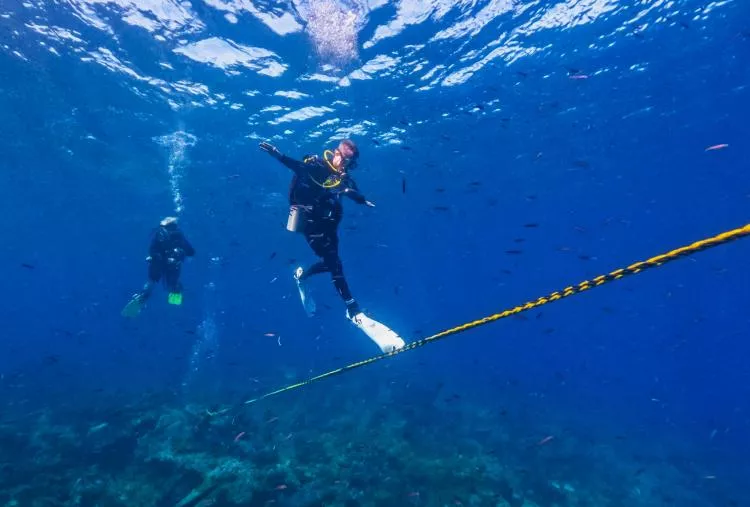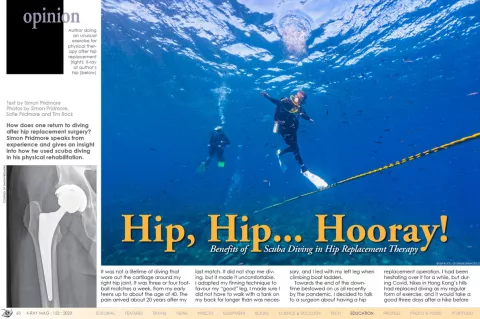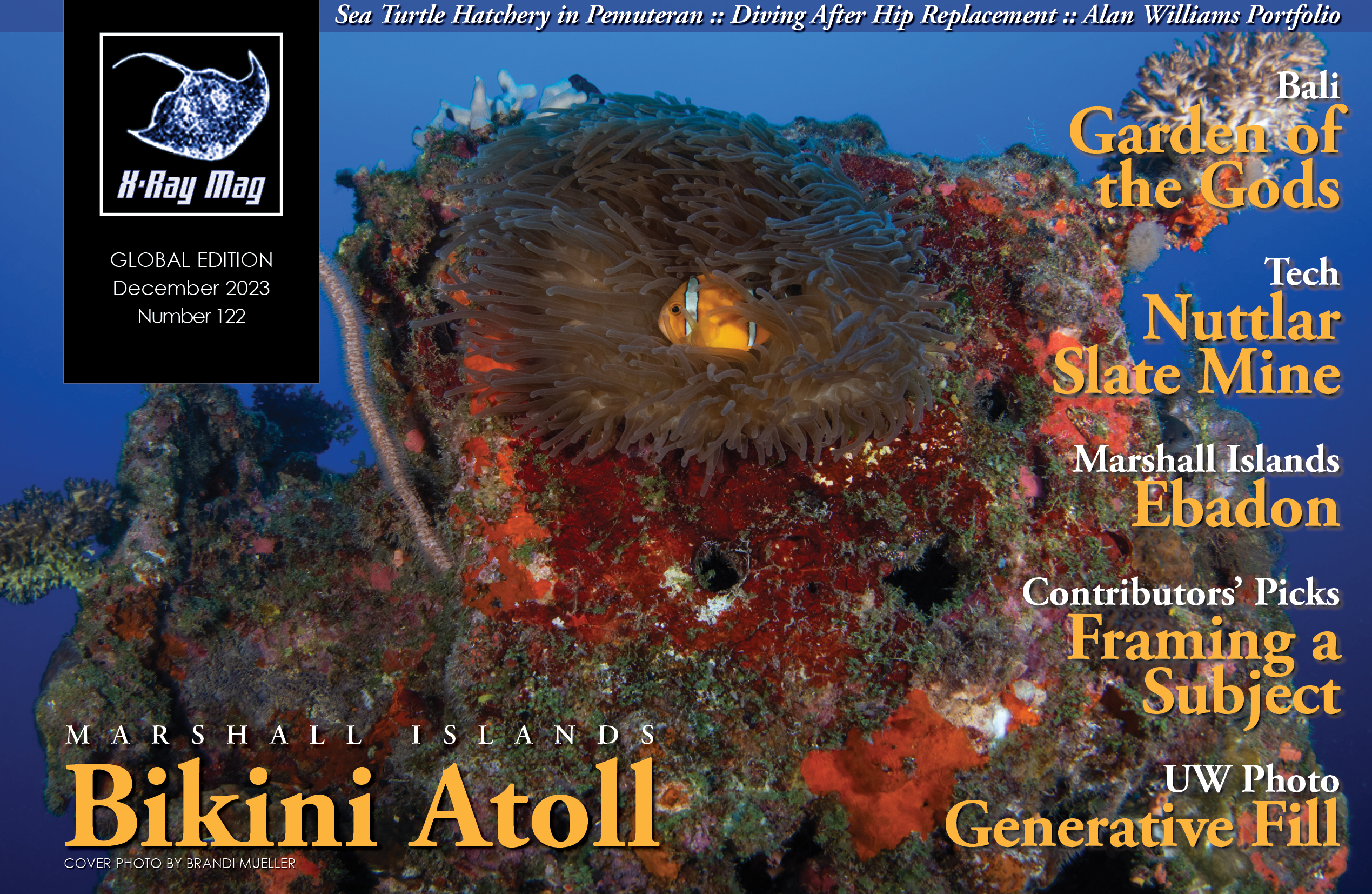How does one return to diving after hip replacement surgery? Simon Pridmore speaks from experience and gives an insight into how he used scuba diving in his physical rehabilitation.
Contributed by
It was not a lifetime of diving that wore out the cartilage around my right hip joint. It was three or four football matches a week, from my early teens up to about the age of 40. The pain arrived about 20 years after my last match. It did not stop me diving, but it made it uncomfortable. I adapted my finning technique to favour my “good” leg, I made sure I did not have to walk with a tank on my back for longer than was necessary, and I led with my left leg when climbing boat ladders.
Towards the end of the downtime bestowed on us all recently by the pandemic, I decided to talk to a surgeon about having a hip replacement operation. I had been hesitating over it for a while, but during Covid, hikes in Hong Kong’s hills had replaced diving as my regular form of exercise, and it would take a good three days after a hike before I stopped hobbling. This could not continue. Something had to be done. So, I sought the advice of Jason Brockwell, Hong Kong’s top hip surgeon and a keen diver himself.
He told me not to wait and that I should have had the operation several yesterdays before. He also introduced me to Yvonne, a marine biologist who had had the operation a year earlier. She was very positive and described the operation as a “new lease of life.”
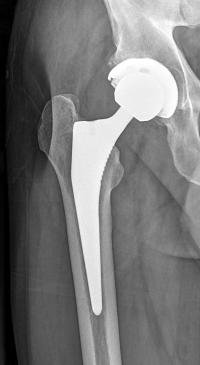
By chance, around the same time, I also bumped into Steve, a Hong Kong course director I used to work with, whom I had not seen for 30 years. We
went for a coffee in the Landmark Starbucks and, as he sat down opposite me, I noticed that he flexed his right leg out and back again. I joked that it looked like he was doing a hip exercise—I had been checking out YouTube videos—and he told me that was exactly what he was doing. He had had his hip replaced three months before.
In his case, it really was scuba diving that robbed him of his hip cartilage. He is not tall enough to hang tanks off the end of his arms as he moves them around, so he would always lean to one side, hitching his hip up, as he walked them from one place to another. Forty years of doing that had left him in arthritic agony.
Steve also advised me to delay no more, so in July 2022, I had the operation. When I signed up, I asked the surgeon if he thought I would be OK to dive three months later, as we were running a dive liveaboard charter in October in Papua New Guinea’s Bismarck Sea. He was optimistic and told me that he and Sophie Raine, a physiotherapist on his team, would prepare me as well as they could.
After surgery
After the operation, on Jason’s direction, I spent six weeks doing as little as possible to give the muscles and tendons that had been cut and resewn time to reconnect, and Sophie just gave me some gentle daily drills to prevent blood clots from forming and to get the new hip joint moving a little.
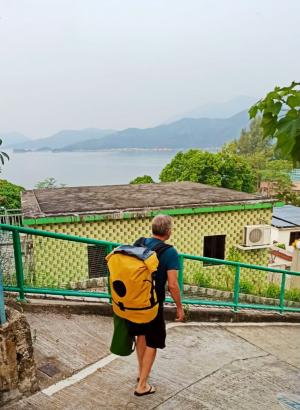
Then, I had an X-ray to make sure all was well and started exercising in earnest. Sophie recommended focusing on hip mobility rather than strength, as my primary aim was to get ready for diving, rather than running or jumping. That would come later. But, of course, the more I walked, the stronger I became, and, over the following six weeks, I could do long walks on flat ground comfortably.
I was assigned some pool work too and the first time I tried using a strong frog kick, I found that as I extended my right leg as far as it would go, I would get a sharp pain close to the hip joint. It turned out that this was all down to a tight gluteus medius, and a sports massage took care of the problem.
By the time we left for the trip, I was able to carry 15kgs of scuba gear on my back down the hill to the ferry pier. Twenty-four hours—comprising one ferry and one bus trip, two flights and a long and very bouncy ride in the back of a van—later, we arrived. My hip felt fine, despite long periods of sitting still and getting jolted around on the last leg of the journey.
But how would the diving go?
Diving
On the first couple of days, the dives were gentle, comprising an hour or so of relaxing reef exploration, almost completely current-free. Entry was via a giant stride from the back of the main boat and exit from the water was via a heavy-duty six-step ladder, followed by five shallow steps from the dive platform to the gearing-up benches.
I toyed with the idea of asking the crew to help me remove my equipment in the water, so I could climb the ladder unburdened, but my ego intruded, and I decided instead to climb the ladder left leg first, bringing my right leg up to join it on each step before moving up to the next. There were handholds all the way up, so I could also use these for support. This meant I was not placing all my body weight—plus a 12-litre aluminium scuba cylinder and 3kgs of lead—on my right leg at any point in the climb. The strategy worked well. I felt no discomfort at all.
In the beginning, I swam with a limited frog kick, then increased my range of movement bit by bit. I sensed a little pressure occasionally during this process, but nothing that could be described as painful. Soon, I was frog-kicking normally, so I started experimenting with other fin kicks—flutter, modified flutter, cave frog, helicopter turns, cave helicopter turns—everything I could think of. I found nothing I could not do and—even better news—after the dive, I had no muscles complaining about what I had put them through—not even my gluteus medius.
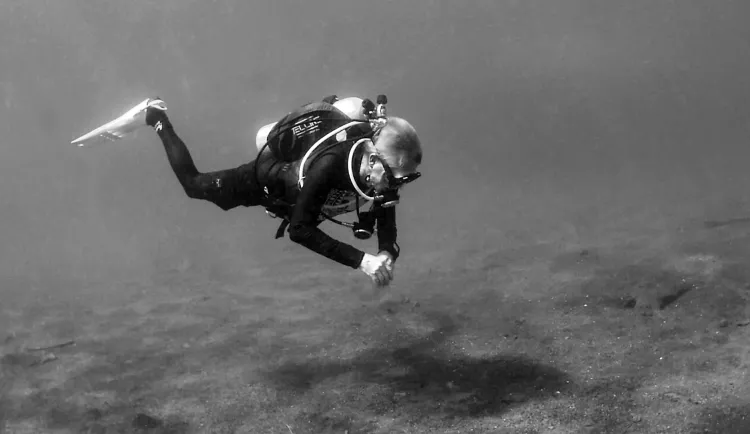
Challenging current
On the morning of day three, I found myself jogging up the internal stairs from the cabins to the dining room for breakfast. It was only when I reached the top that I realised I had not jogged up a staircase for five years!
Later that day, my buddy and I did a giant stride off the stern into a ripping current and grabbed onto the tagline. The place we needed to be was on a reef point, in front of the boat. We had two choices. We could either drop to the seabed and pull and glide our way forward, using the contours to give us shelter from the current; or we could fin along the tagline just under the surface to the bow, then follow the mooring line, hand-over-hand to the seabed.
The problem with option one was that the reef top was very rich, with fragile corals overlaying each other and very few bare patches of rock or sand to pull and glide across. There was a risk that staying low to get shelter from the current might bring our fins into occasional contact with the corals. This I wanted to avoid.
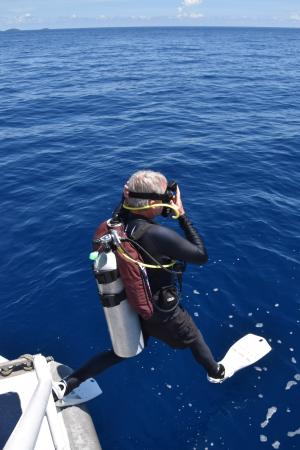
So, it had to be option two. Before the hip operation, even with my bad hip, the swim against the current along the tagline would not have presented any problem. Now, I knew it would be the most significant test of my strength and endurance so far. I signalled to my buddy. She agreed and we set off.
Getting there
It was slow going at first, but I switched fin strokes from time to time and made constant progress. Arriving at the mooring line, we descended fast. I was anticipating what we would find when we eventually arrived at the sweet spot where the point jutted farthest out into the blue. There would be schools of predatory fish such as black snapper, bluefin trevally and mackerel chasing and feeding on large schools of small fry or just hanging in the “wind,” facing the flow.
It was just a matter of getting there. From the mooring point, we headed out along and down the wall. There were rocky handholds that I could use to pull myself along to take the strain off my legs a little, but there were still sections where I had to kick hard for a few seconds to bridge the gap. Finally, we made it and found a chunk of bare rock to cling onto as we watched the excitement going on all around us.
The ocean from the surface to the deep blue depths was suffused with life. Fusiliers raced up and down the wall like in a chariot race in a Roman circus; predators were carrying out their usual lightning raids on the confused conglomerations of “little-‘uns,” which were dodging and diving in unison to avoid becoming a mid-morning snack, and occasional passers-by, such as Māori wrasse, dogtooth tuna and oriental sweetlips, were coming in to join the fray.
That evening, I ached, but only in both quadriceps. However, the following morning, my right hip felt tight, and I spent the first dive (just after dawn) flexing and stretching my hip and butt muscles. The tightness continued all day, so I took some Panadol and continued practising extensions and flexes. At the end of the last dive that day, I tried coming up the ladder normally and found I had the strength to do it. Neither my hip nor my muscles raised any objection.
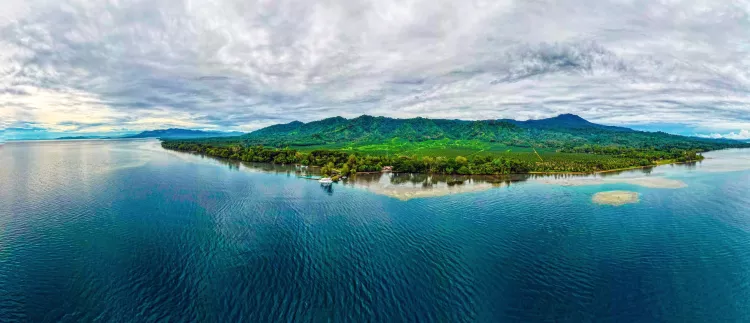
Wave action
Two days later, we dived down onto a deep pinnacle to watch a school of barracuda circling around in the blue. It was calm when we set out, but by the time we surfaced, the weather had changed, a storm was coming in and the sea was getting rough. Exit from the ocean needed to be as usual via the boat ladder, which was slamming up and down as big waves struck the stern.
At first sight, in conditions like these, it seems impossible that you will be able to exit safely. But the ocean has a rhythm and there are moments between waves when the ladder is stable, and you can get onto it. You then grip it tightly, so that when the next wave comes, you will not be torn off and chucked back into the churning spume behind the boat. Then, you can use the next period of calm to scoot up the ladder and onto the dive deck. If you are lucky—and nimble—you get there, grab on, and climb up in one continuous movement.
Timing and speed are required. There is no dawdling allowed. You wait patiently just out of range of the ladder as it does its rising-up-and-crashing-down thing, wait for an opportunity, make your decision, and go for it. Good dive boat ladders are designed so you can climb up them with fins on. This one was a good dive boat ladder—although I could see a pesky loose length of line halfway up that looked like a potential trip wire. I measured the gap between waves and thought that I would have enough time when the moment arrived to get on, get up and get gone in one push. But I would have to climb up normally—left foot on one rung, right foot on the next and so on. Speed, as they say, would be of the essence.
So that was what I did. I waited for a patch of calm, glanced behind me, saw that there was no major swell bearing down and finned hard for the stern. I grabbed the central pillar on the ladder with both hands, swung my fins onto the bottom rung and shot up the steps like a rat scrabbling up a drainpipe, avoiding the trailing line and arriving on deck just in time to get a good grip on the railing before the next wave hit.
Home safe.
My buddy arrived on board via a similar route shortly afterwards and saw me standing waiting for her with a big smile on my face.
“I saw that,” she said. “Nothing wrong with your hip now.”
The healing power of scuba diving! I felt like cheering out loud. ■

